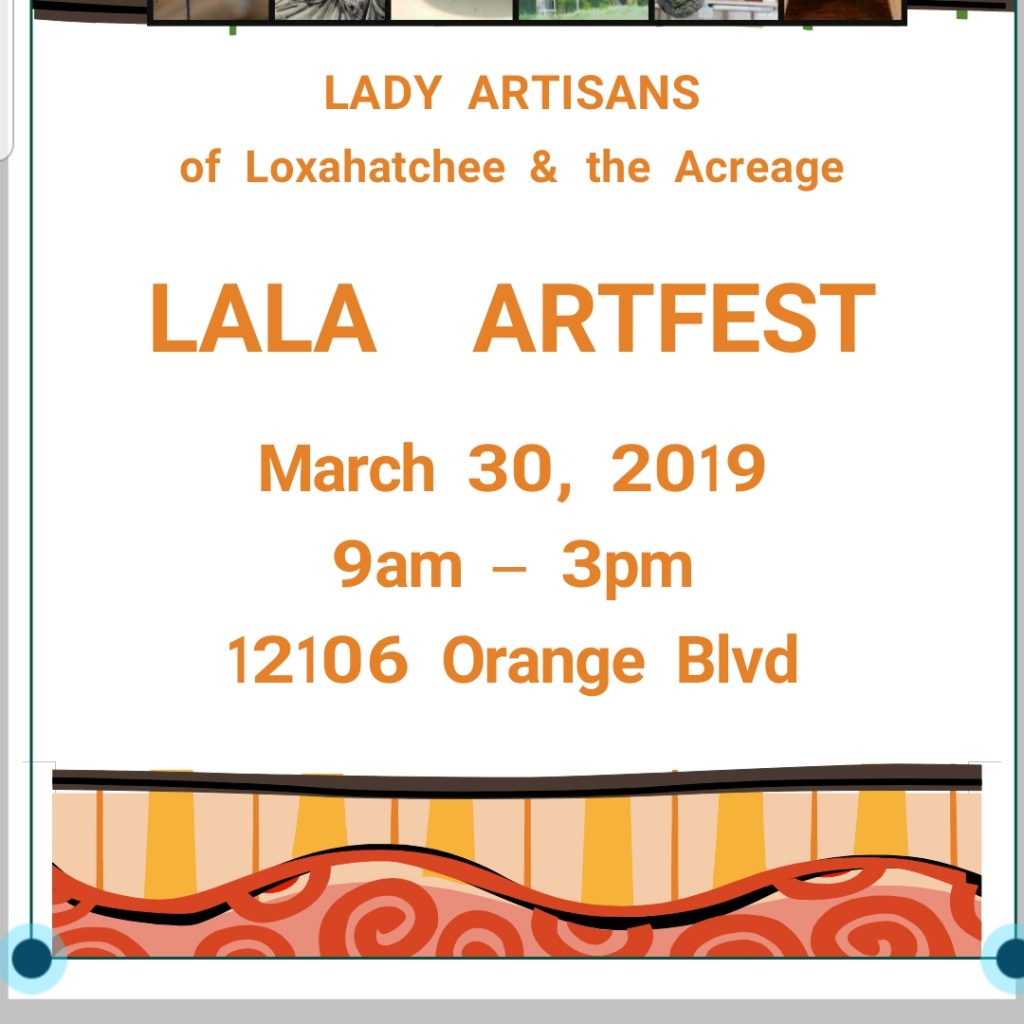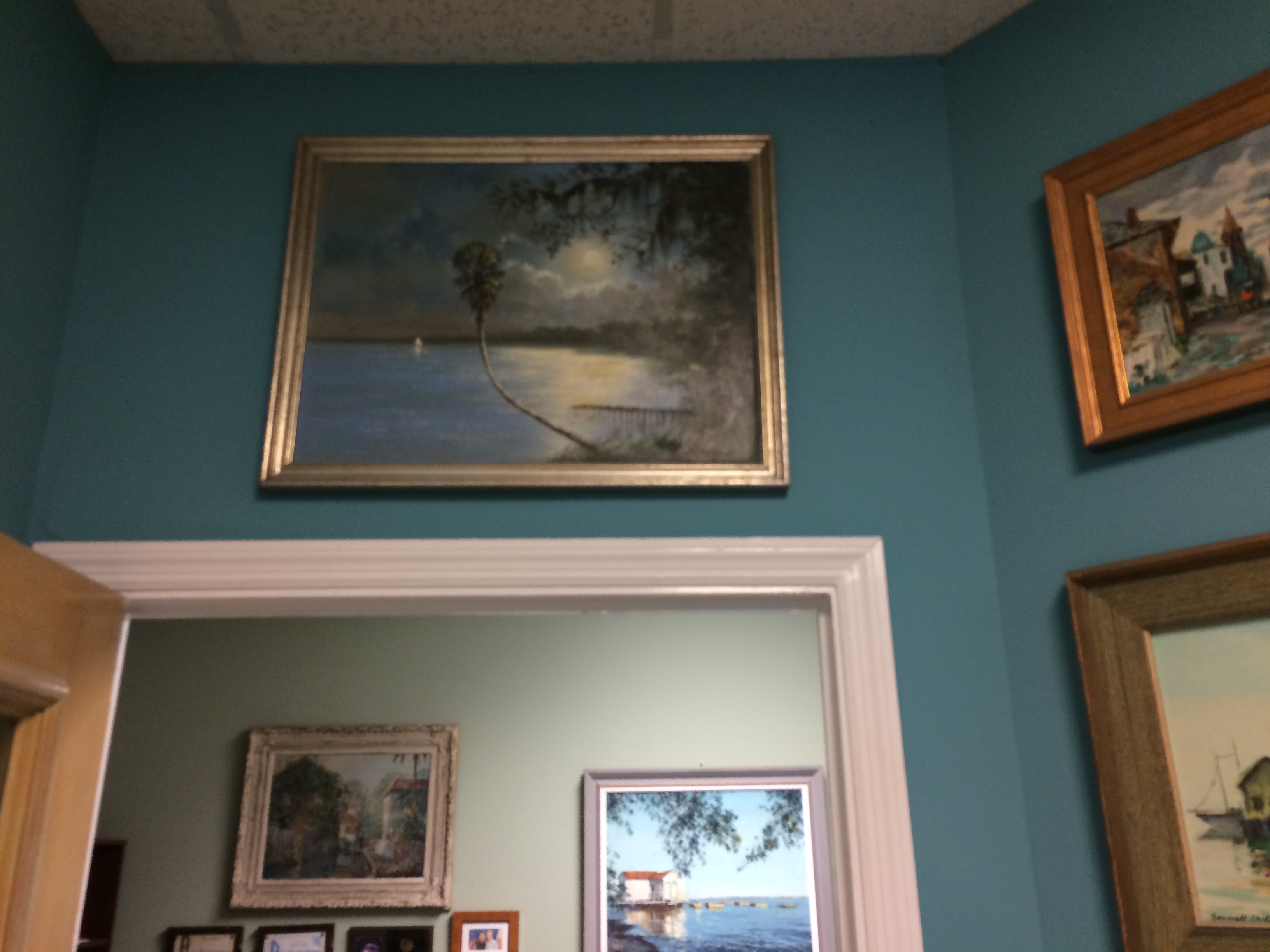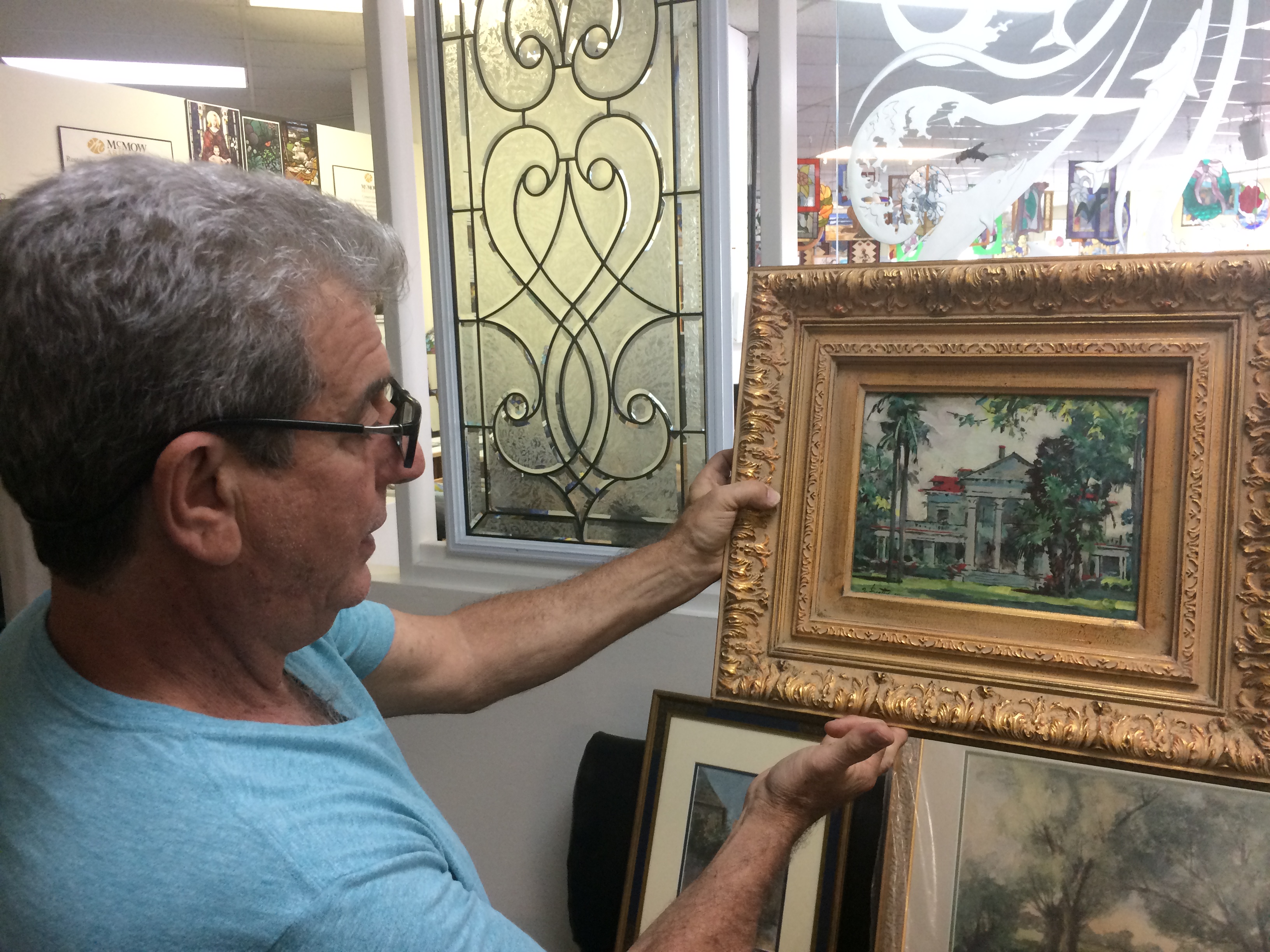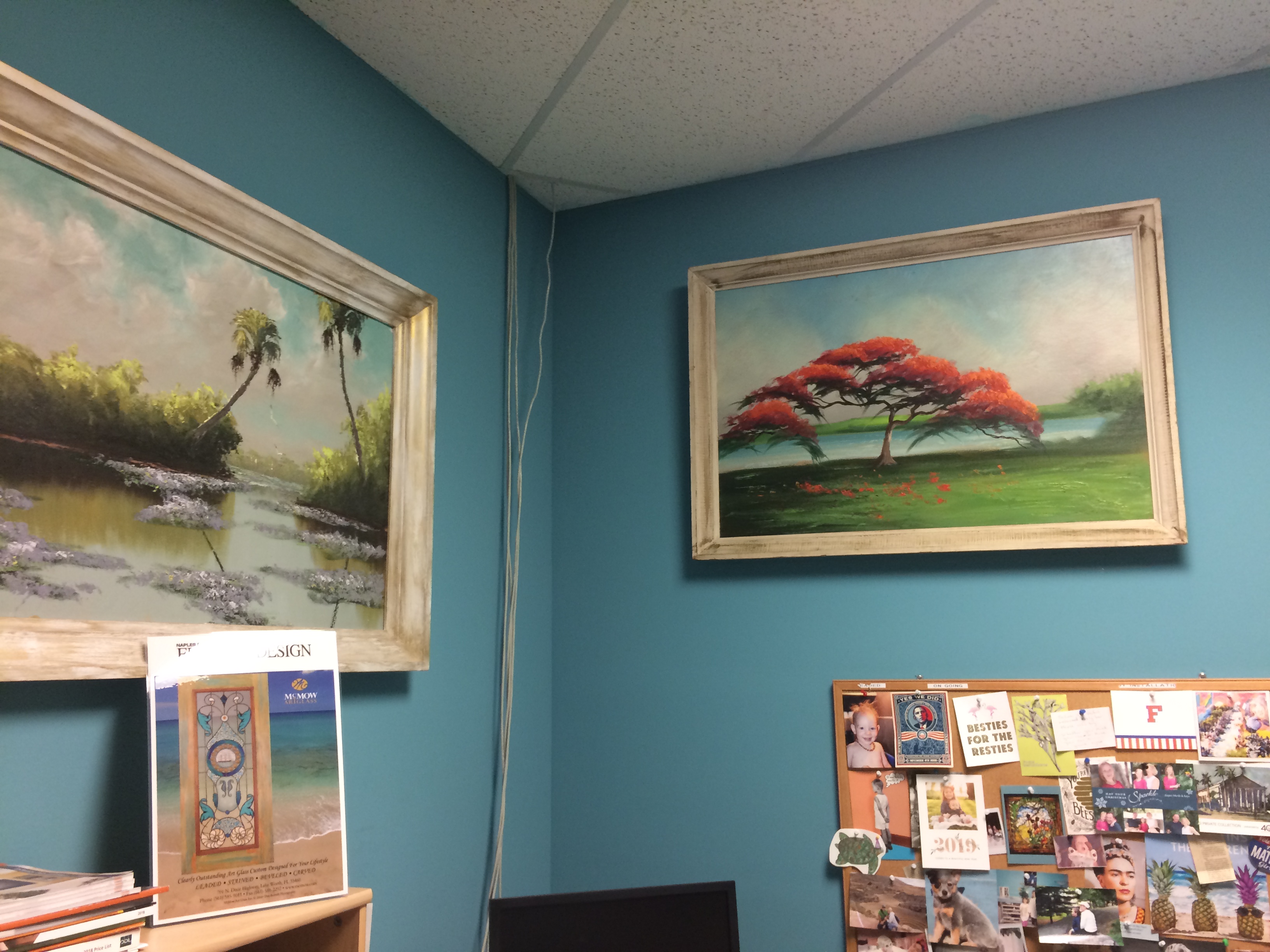


The Lady Artisans of Loxahatchee and The Acreage is a group of women artists from Loxahatchee and the Acreage who have come together to sell their art and showcase their unique talents.
LALA is holding its second ARTFEST on March 30, 2019 from 9AM to 3PM at 12106 Orange Blvd.
The talented women artisans will be selling their artistic creations which include pottery, wood art, jewelry, painting, glass, handmade cards, ornaments, angels, candles, handmade soap, acrylic window art, embroidered linens and quilts and much more. This is the perfect place to get your Easter and Mother’s Day shopping done and support local women artists in our community.
Each LALA artist has donated a piece of their art to Shoppe 561 in support of The Place of Hope.
Along with handmade creations, LALA is proud to host the Venturing Scouts who will be selling homemade baked goods and drinks. The Scouts are fundraising to support their scouting adventures. Come out and show the Scouts that you support their troop.
For more information please see the LALA Facebook page.
Journey of a Blue Collar Collector – Part One
Motel Art to Masterpiece
By Angela Shaw
It all started over breakfast one morning when Phil Materio and his daughter were reading the Sunday paper. The 1996 article was about a group of mid-century African American painters who made a side living by peddling their landscape oils. Jim Crow laws still reigned in South Florida and forced people of color to take low paying jobs. The enterprising men—later dubbed “The Highwaymen”— would pitch their paintings to tourists, residents and shop owners. Originally selling from 17 to 75 dollars each, the painters knew they weren’t creating great art; they were just trying to make ends meet. Soon the artwork decorated the walls of banks, motels, attorney and dental offices. The news column went on to say that although the value of these landscapes was on the rise, they could still be found for a steal at garage sales, thrift shops and flea markets.

As a stained glass artist and craftsman, Mr. Materio’s interest was immediately piqued and he and his daughter went right out to Lake Worth’s antique row to see what they could find. The first store they walked into surprisingly revealed three Highwaymen paintings. Phil scooped them up for $17 to $26 a piece. His interest quickly turned into a veritable obsession and propelled him into a statewide search for Highwaymen art. With a self-imposed limit of $100 per painting, he scoured the state for these new found treasures.
Who’d have thought a mere news article could launch a lifelong quest?

Materio didn’t always have to travel far in order to build his collection. One of his neighbors was a doctor. When Phil asked him if he happened to have any of these paintings in his office, surprisingly, he said that he owned three. Phil was happy his neighbor agreed to sell two for $100.
Through his search, Materio acquired a deep knowledge of Florida’s social, political and cultural history. The Highwaymen community was centered in the Fort Pierce area, spearheaded by American Impressionist Albert Backus. Considered the “Dean of Florida Landscape painting,” Backus’ bohemian air fostered inclusion of all races and classes. He would invite people of every stratum to his house for art-centered gatherings.
One such guest was Alfred Hair who became one of Backus’ most enthusiastic students and a Highwaymen leader. Like other African Americans who worked in packing houses, factories and farms, he was a laborer. Ambitious and hard-working, Alfred set his sights on two things: (1) a Cadillac and, (2) a house in Miami. Under the tutelage of Albert Backus, Hair began painting scenes of Florida’s terrain and skies in exaggerated colors; palms, Poinciana, grasses, rivers and lakes, mountainous clouds and flaming sunsets. Costs were minimized by using crown molding for frames and painting on Upson board (compressed fibers) instead of canvas. After Alfred sold enough artwork he bought his prized Cadillac. When envious friends asked where he got the money, they joined him in his painting venture. Alfred trained them in the Backus style, but no one could paint as fast as Hair. It was said he could finish one painting in an hour. Unfazed by potential competition, Backus had told his art students, “I don’t care if you paint like me as long as you sell them for cheap.”
The artists sold their works door-to-door, along roadsides and out of their trunks, sometimes with the paint still wet. The 26 “official” Highwaymen included Alfred Hair, Harold Newton, Roy McClendon, Livingston Roberts, Al Black, Hezekiah Baker, James Gibson and Maryann Carroll—the sole female—to name a few.
Alfred Hair never got his home in Miami, as his life was cut short in 1970, but he endowed Floridians with a unique genre of far more worth than a house. It took a while, however, for the art form to rise from mediocrity to fine art. Well into the 80’s the Florida landscape paintings were still relegated to motel walls and dentists offices.
It wasn’t until the early 2000s that the works started to appreciate. A few books and movies documented the Highwaymen’s story of struggle and success and generated a new public interest. The popularity prompted dealers to raise prices. Materio says it’s remarkable that in two decades, while many collectibles have dropped in price, these paintings have suffered no decline.

While Phil had amassed hundreds of Highwaymen pieces, he wondered if this was the only art of note in the Sunshine State. Were there other Florida-based painters to be discovered? After reading Mabel Mann’s Art in Florida, he learned that there were three main creative hubs: Saint Augustine, Sarasota and Palm Beach. Materio threw himself into gathering the artwork of these communities. His blue-collar philosophy (much like a good stock investor’s) was to buy undervalued pieces and watch them appreciate. After twenty years of collecting, 500 paintings and two storage units, his McMow Art Glass studio walls are a testament to his passion.
In Part Two of Journey of a Blue-Collar Collector, share in Phil Materio’s discoveries of images of Sarasota’s circus oddities, Palm Beach’s mansions that no longer exist and St. Augustine’s charming street scenes that have survived the centuries.

“Marchtoberfest” Traditional German Biergarten Pops-Up
THIS WEEKEND in Wellington, March 7–9
Come celebrate “Marchtoberfest” in Wellington with a traditional pop-up German Biergarten featuring Hofbräu Bier. Marchtoberfest is set to occur over three days, Thursday through Saturday, March 7-9, in Wellington’s Town Center (12150 Forest Hill Boulevard). Admission is FREE.
The event runs from 5:00 p.m. to 10:00 p.m., Thursday through Friday; and 12:00 p.m. to 10:00 p.m. on Saturday. On Thursday, March 7, join the Village of Wellington for a Ceremonial Keg Tapping at 7:00 p.m.
Each day will feature a lounge area of authentic Biergarten tables and benches, along with German food, music, and special entertainment on select days (schedule below). Kids will enjoy their very own activity zone sponsored by Joe DiMaggio Children’s Health Specialty Center, featuring an inflatable bounce house, obstacle course, sports challenge, slides, and lawn games. Guests 21 and over can choose from a selection of beers by Hofbräu München, available for purchase, along with keepsake boots or steins with discounted prices for refills.
Schedule of special
entertainment:
Thursday, March 7th
6:00 pm and 7:30 pm
Enjoy performances by German dance group Volkstanzgruppe, of the American German Club of the Palm Beaches.
Friday, March 8th
5:30 pm to 9:30 pm
The “Henry and Bob Duo” will be playing accordion renditions of popular German
and pop songs.
Saturday, March 9th
2:00 pm to 4:00 pm and 6:00 pm to 8:00 pm
German band, Melody Lane “Florida Edition,” will be playing live on stage.
1:00 pm to 1:30 pm and 4:00 pm to 4:30 pm
See “Black Horse Stables” jousting exhibitions presented by All Kids
Entertainment.
For full event details visit www.wellingtonfl.gov/Marchtoberfest
As another way to stay informed on the latest news and updates from the
Village, residents are invited to sign up for Wellington information and
updates at www.wellingtonfl.gov/enews.
On Saturday, March 2nd, 2019, over 400 supporters gathered together to watch a special tennis exhibition presented by the Israel Tennis Centers Foundation at Wycliffe Golf and Country Club. CEO of Israel Tennis Centers Ari Strasberg traveled from Israel to speak on this special occasion. Here’s a brief interview with him.
And here’s a brief interview with a couple of the young tennis players who have benefited from being a part of Israel Tennis Centers, Koral and Tuval.
Sweden’s capital city encompasses 14 islands and more than 50 bridges on an extensive Baltic Sea archipelago. It’s a vibrant modern city tempered by the historic ochre-colored buildings of the Old Town dating back to the 13th-century. It’s full of surprises too—like the elaborate art under its streets a rocking museum and a boat resurrected from a watery grave after 333 years. There’s so much to see and experience in Stockholm, let’s explore some of the highlights.

Stockholm‘s subway system is home to the world’s longest art gallery. Sculptures, mosaics
In Stockholm you can sing, dance and sleep with ABBA—well sort of. Interactive exhibits at ABBA The Museum let you join the act of the iconic Swedish foursome. Get on stage with holographic images of the band members to sing and dance your way to stardom. Try out virtual stage costumes, mix music and sing “Dancing Queen” to your heart’s content. There’s plenty of ABBA memorabilia on display including gold records, instruments and performance costumes.
As for sleeping with the group, book a room at the ABBA-themed Pop House. Connected to the museum, this hotel has ABBA-inspired rooms, a restaurant, bar, and live music on the patio playing…you guessed it, ABBA hits.

Setting off on its maiden voyage on August 10, 1628, the massive warship, Vasa, was the pride of the Swedish crown…for a brief moment. Within minutes, the top-heavy vessel fraught with miscalculations sank to the bottom of Saltsjön where it remained for 333 years. Talk about a bad day at work!
But, l
Get a dose of royalty at the impressive 40-minute Royal Guards ceremony at the Royal Palace of Stockholm. Donned in blue and white uniforms the impeccable guards, accompanied by a military band, parade towards the palace from the nearby Cavalry Barracks. The ceremonious changing of the guard is completed in the palace courtyard.
The palace interior yields more royal treasures including opulent chandeliers, period furnishings, golden coronation carriages and jewel-encrusted swords. As the official residence of the Swedish royal family since the 1700s, the palace has more than 600 rooms. Guided tours are available to delve deeper into the historic splendor of the palace.

With its abundance of islands, waterways, gardens, wooded trails and parks, Stockholm is a nature-lovers paradise. It’s not surprising to see perfectly manicured gardens at every turn. What is unexpected and unique are the allotments. In the middle of the city, residents are granted allotments for small parcels of land for gardening. Along with the color-infused gardens, the allotments have tiny brightly painted wooden garden cottages equipped with kitchens and a small room for napping or just hanging out. There are more than 100 allotments scattered about on Tantolunden’s hillside make this one of the city’s most picturesque parks.
Even if you’re not fortunate enough to have an allotment (or know someone who does!) you can still enjoy the park. Stroll along the well-worn paths or garner a front row seat to watch the passing boats on one of the park’s many benches. Visiting in winter? Check out the toboggan ride for a good time in the snow.
Isn’t it time you checked out Stockholm?
SEDUCED and TRAPPED by an innocent-looking cake!
The Sweethearts (our married Dessert Reviewers Frannie and Dani) happened to be walking by the she-she Italian restaurant Sant Ambroeus, Palm Beach when they felt an unavoidable calling – a religious experience of sorts. Suddenly, they were rendered helpless into full cake domination. Watch and learn from their experience (CLICK LINK) – hopefully it will happen to you many times over!
SANT AMBROEUS
340 Royal Poinciana Way